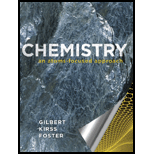
To write:
The balanced equation for the cell for each pair and identify which half-reaction takes place at anode and which at cathode.
Answer to Problem 17.32QA
Solution:
a) Anode:
Cathode:
----------------------------------------------------------------------------------
Balanced equation:
b) Anode:
Cathode:
----------------------------------------------------------------------------------------------------------------
Balanced equation:
c) Anode:
Cathode:
--------------------------------------------------------------------------------------------------
Balanced equation:
Explanation of Solution
1) Concept:
We are asked to write and balance the cell reaction from the given pair. Values of standard reduction potential are given in appendix 6, table A6.1. Higher the standard reduction potential, higher is the tendency to reduce. So the element that has a negative or small value of standard reduction potential is more likely to oxidize. Therefore, we reverse that reaction to make it an oxidation half reaction. For an
Adding two half
2) Formula:
3) Given:
i)
ii)
iii)
4) Calculations:
The standard reduction potential values for all these reactions are taken from the Appendix 6, table A6.1.
a.
Since the standard reduction potential for
In the first pair of reactions, the number of electrons is not the same, so we need to balance it. So, multiply the second reaction by 2, and we get
So,
Now add two half balanced reactions:
Anode:
Cathode:
-------------------------------------------------------------------------
b.
Since the standard reduction potential for the second reaction is higher than that of the first reaction, the second given reaction will serve as a cathode and undergo a reduction half reaction, and the first given reaction will serve as an anode and undergo an oxidation half reaction.
In the second pair of reactions, the number of electrons is not the same, so we need to balance it. So, multiply the first reaction by
Now add two half reactions:
Anode:
Cathode:
----------------------------------------------------------------------------------------------------------------
c.
Since the standard reduction potential for the second reaction is higher than that of the first reaction, the second given reaction will serve as a cathode and undergo a reduction half reaction, and the first given reaction will serve as an anode and undergo an oxidation half reaction.
In the third pair of reactions, electrons are not the same, so we need to balance them, so, multiply second reaction by 2. We get
So,
Now add two half balanced reactions:
Anode:
Cathode:
-------------------------------------------------------------------------------------------
Conclusion:
For an electrochemical cell, higher the standard reduction potential, higher is the tendency to reduce (cathode). So, the reaction that has a negative or small value of standard reduction potential is more likely to oxidize (anode). Therefore, this reaction is reversed to get the oxidation reaction that will take place at the anode. The reaction with a higher value of standard reduction potential is the reduction reaction that will take place at the cathode.
Want to see more full solutions like this?
Chapter 17 Solutions
Chemistry: An Atoms-Focused Approach
 ChemistryChemistryISBN:9781305957404Author:Steven S. Zumdahl, Susan A. Zumdahl, Donald J. DeCostePublisher:Cengage Learning
ChemistryChemistryISBN:9781305957404Author:Steven S. Zumdahl, Susan A. Zumdahl, Donald J. DeCostePublisher:Cengage Learning ChemistryChemistryISBN:9781259911156Author:Raymond Chang Dr., Jason Overby ProfessorPublisher:McGraw-Hill Education
ChemistryChemistryISBN:9781259911156Author:Raymond Chang Dr., Jason Overby ProfessorPublisher:McGraw-Hill Education Principles of Instrumental AnalysisChemistryISBN:9781305577213Author:Douglas A. Skoog, F. James Holler, Stanley R. CrouchPublisher:Cengage Learning
Principles of Instrumental AnalysisChemistryISBN:9781305577213Author:Douglas A. Skoog, F. James Holler, Stanley R. CrouchPublisher:Cengage Learning Organic ChemistryChemistryISBN:9780078021558Author:Janice Gorzynski Smith Dr.Publisher:McGraw-Hill Education
Organic ChemistryChemistryISBN:9780078021558Author:Janice Gorzynski Smith Dr.Publisher:McGraw-Hill Education Chemistry: Principles and ReactionsChemistryISBN:9781305079373Author:William L. Masterton, Cecile N. HurleyPublisher:Cengage Learning
Chemistry: Principles and ReactionsChemistryISBN:9781305079373Author:William L. Masterton, Cecile N. HurleyPublisher:Cengage Learning Elementary Principles of Chemical Processes, Bind...ChemistryISBN:9781118431221Author:Richard M. Felder, Ronald W. Rousseau, Lisa G. BullardPublisher:WILEY
Elementary Principles of Chemical Processes, Bind...ChemistryISBN:9781118431221Author:Richard M. Felder, Ronald W. Rousseau, Lisa G. BullardPublisher:WILEY





